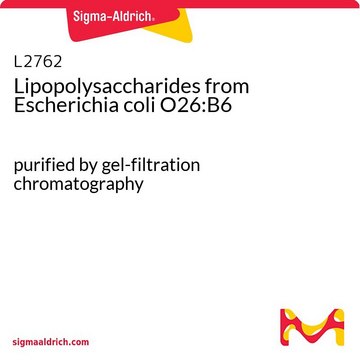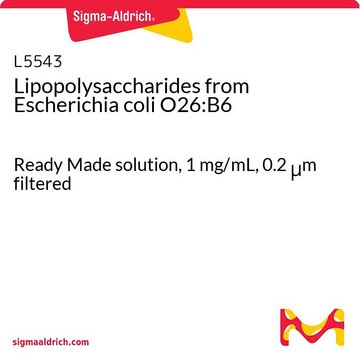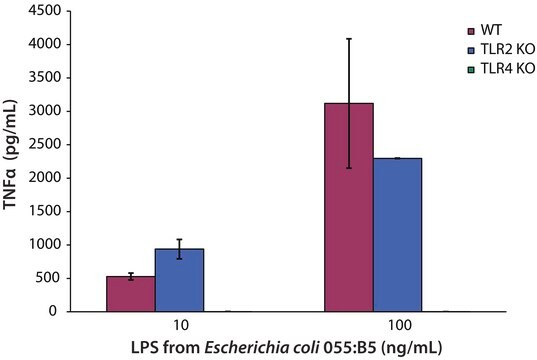L2654
Lipopolysaccharides from Escherichia coli O26:B6
γ-irradiated, BioXtra, suitable for cell culture
Synonym(s):
LPS
Sign Into View Organizational & Contract Pricing
All Photos(2)
About This Item
Recommended Products
biological source
Escherichia coli (O26:B6)
Quality Level
sterility
γ-irradiated
product line
BioXtra
form
lyophilized powder
purified by
gel-filtration chromatography
technique(s)
cell culture | mammalian: suitable
impurities
<5% Protein (Lowry)
solubility
H2O: 5 mg/mL, slightly hazy
storage temp.
2-8°C
Looking for similar products? Visit Product Comparison Guide
Application
Lipopolysaccharides (LPSs) are characteristic components of the cell wall of Gram-negative bacteria. LPS and its lipid A moiety stimulate cells of the innate immune system by the Toll-like receptor 4 (TLR4), a member of the Toll-like receptor protein family, which recognizes common pathogen-associated molecular-patterns (PAMPs).
Lipopolysaccharides from Escherichia coli 026:B6 was used to elicit the secretion of cytokines by human PBMC, murine bone marrow dendritic cells and rat astrocytes.
Biochem/physiol Actions
LPS is a major constituent of the cell wall of most gram negative bacteria. It is a highly immunogenic antigen with the ability to enhance immune responses to soluble antigens. LPS also acts as a specific mitogen for bone marrow derived B lymphocytes from mice, rabbits, chickens, cows, hamsters, and humans.
Reconstitution
Lipopolysaccharides are supplied as lyophilized, γ-irradiated powders. To reconstitute, add 1 ml sterile balanced salt solution or tissue culture medium to the vial (1 mg) and gently swirl until the powder dissolves. Reconstituted product may be further diluted to desired working concentrations using sterile balanced salt solution or tissue culture medium.
Other Notes
To gain a comprehensive understanding of our extensive range of Lipopolysaccharides for your research, we encourage you to visit our Carbohydrates Category page.
related product
Product No.
Description
Pricing
Signal Word
Danger
Hazard Statements
Precautionary Statements
Hazard Classifications
Acute Tox. 2 Oral
Storage Class Code
6.1A - Combustible acute toxic Cat. 1 and 2 / very toxic hazardous materials
WGK
WGK 3
Flash Point(F)
Not applicable
Flash Point(C)
Not applicable
Choose from one of the most recent versions:
Already Own This Product?
Find documentation for the products that you have recently purchased in the Document Library.
Customers Also Viewed
Patricia Cassina et al.
Journal of neuroscience research, 67(1), 21-29 (2001-12-26)
Oxidative stress mediated by nitric oxide (NO) and its toxic metabolite peroxynitrite has previously been associated with motor neuron degeneration in amyotrophic lateral sclerosis (ALS). Degenerating spinal motor neurons in familial and sporadic ALS are typically surrounded by reactive astrocytes
Asad Ali et al.
The Journal of steroid biochemistry and molecular biology, 180, 73-80 (2018-02-07)
Emerging evidence suggests that maternal or developmental vitamin D (DVD) deficiency is a risk factor for Autism Spectrum Disorders. A well-established association has also been found between gestational infection and increased incidence of autism. Placenta mediates the maternal immune response
S Ménard et al.
Gut, 53(6), 821-828 (2004-05-13)
Probiotic bacteria have a beneficial effect on intestinal inflammation. In this study, we have examined the effect of lactic acid and commensal Gram positive (+) bacteria conditioned media (CM) on tumour necrosis factor alpha (TNF-alpha) release and the mechanisms involved.
Lukas Muri et al.
Journal of neuroinflammation, 16(1), 156-156 (2019-07-29)
Pneumococcal meningitis is associated with high risk of neurological sequelae such as cognitive impairment and hearing loss. These sequelae are due to parenchymal brain and inner ear damage primarily induced by the excessive inflammatory reaction in response to bacterial brain
Ø Salvesen et al.
Journal of neuroinflammation, 14(1), 106-106 (2017-05-24)
The cellular prion protein (PrP In order to explore putative roles for PrP All LPS-treated goats displayed clinical signs of sickness behavior, which were of significantly (p < 0.01) longer duration in animals without PrP Our data suggest that PrP
Our team of scientists has experience in all areas of research including Life Science, Material Science, Chemical Synthesis, Chromatography, Analytical and many others.
Contact Technical Service



